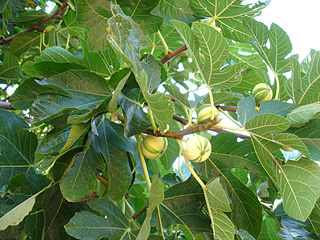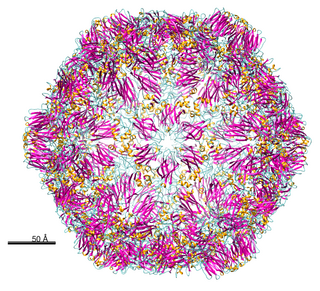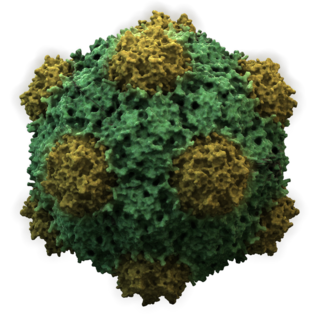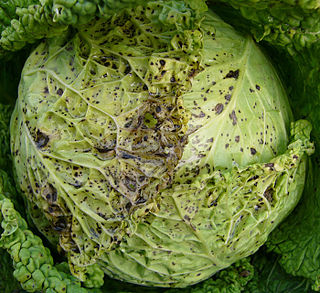
Variegation is the appearance of differently coloured zones in the leaves and sometimes the stems and fruit of plants. Species with variegated individuals are sometimes found in the understory of tropical rainforests, and this habitat is the source of a number of variegated houseplants. Variegation is caused by mutations that affect chlorophyll production or by viruses, such as mosaic viruses, which have been studied by scientists. The striking look of variegated plants is desired by many gardeners, and some have deliberately tried to induce it for aesthetic purposes. There are a number of gardening books about variegated plants, and some gardening societies specialize in them.

Potyvirus is a genus of positive-strand RNA viruses in the family Potyviridae. Plants serve as natural hosts. The genus is named after member virus potato virus Y. Potyviruses account for about thirty percent of the currently known plant viruses. Like begomoviruses, members of this genus may cause significant losses in agricultural, pastoral, horticultural, and ornamental crops. More than 200 species of aphids spread potyviruses, and most are from the subfamily Aphidinae. The genus contains 190 species.

Begomovirus is a genus of viruses, in the family Geminiviridae. They are plant viruses that as a group have a very wide host range, infecting dicotyledonous plants. Worldwide they are responsible for a considerable amount of economic damage to many important crops such as tomatoes, beans, squash, cassava and cotton. There are 445 species in this genus.

Nepovirus is a genus of viruses in the order Picornavirales, in the family Secoviridae, in the subfamily Comovirinae. Plants serve as natural hosts. There are 40 species in this genus. Nepoviruses, unlike the other two genera in the subfamily Comovirinae, are transmitted by nematodes.

Alfalfa mosaic virus (AMV), also known as Lucerne mosaic virus or Potato calico virus, is a worldwide distributed phytopathogen that can lead to necrosis and yellow mosaics on a large variety of plant species, including commercially important crops. It is the only Alfamovirus of the family Bromoviridae. In 1931 Weimer J.L. was the first to report AMV in alfalfa. Transmission of the virus occurs mainly by some aphids, by seeds or by pollen to the seed.

Cymbidium mosaic virus (CymMV) is a plant pathogenic virus of the family Alphaflexiviridae.
Potato yellow mosaic virus (PYMV) is a plant pathogenic virus of the family Geminiviridae.
Wild potato mosaic virus (WPMV) is a plant pathogenic virus of the family Potyviridae.
Sowbane mosaic virus (SoMV) is a pathogenic plant virus, infecting potato and grapevine. Infected species present chlorotic mottling and lesions, followed by yellow flecking and star-shaped patterns.

Potexvirus is a genus of pathogenic viruses in the order Tymovirales, in the family Alphaflexiviridae. Plants serve as natural hosts. There are 48 species in this genus, three of which are assigned to a subgenus. Diseases associated with this genus include: mosaic and ringspot symptoms. The genus name comes from POTato virus X).

Carlavirus, formerly known as the "Carnation latent virus group", is a genus of viruses in the order Tymovirales, in the family Betaflexiviridae. Plants serve as natural hosts. There are 53 species in this genus. Diseases associated with this genus include: mosaic and ringspot symptoms.

Aucuba japonica, commonly called spotted laurel, Japanese laurel, Japanese aucuba or gold dust plant (U.S.), is a shrub native to rich forest soils of moist valleys, thickets, by streams and near shaded moist rocks in China, Korea, and Japan. This is the species of Aucuba commonly seen in gardens - often in variegated form. The leaves are opposite, broad lanceolate, 5–8 cm (2.0–3.1 in) long and 2–5 cm (0.79–1.97 in) wide. Aucuba japonica are dioecious. The flowers are small, 4–8 mm (0.16–0.31 in) diameter, each with four purplish-brown petals; they are produced in clusters of 10-30 in a loose cyme. The fruit is a red drupe approximately 1 cm (0.39 in) in diameter that is avoided by birds.

Myzus persicae, known as the green peach aphid, greenfly, or the peach-potato aphid, is a small green aphid belonging to the order Hemiptera. It is the most significant aphid pest of peach trees, causing decreased growth, shrivelling of the leaves and the death of various tissues. It also acts as a vector for the transport of plant viruses such as cucumber mosaic virus (CMV), potato virus Y (PVY) and tobacco etch virus (TEV). Potato virus Y and potato leafroll virus can be passed to members of the nightshade/potato family (Solanaceae), and various mosaic viruses to many other food crops.

Macrosiphum euphorbiae, the potato aphid, is a sap-sucking pest insect in the family Aphididae. It infests potatoes and a number of other commercially important crops.
Cavemovirus is a genus of viruses, in the family Caulimoviridae order Ortervirales. Plants serve as natural hosts. There are three species in this genus. Diseases associated with this genus include: vein-clearing or banding mosaic.

Comovirus is a genus of viruses in the order Picornavirales, in the family Secoviridae, in the subfamily Comovirinae. Plants serve as natural hosts. There are 15 species in this genus.

Tymovirus is a genus of viruses in the order Tymovirales, in the family Tymoviridae. Plants serve as natural hosts. There are 28 species in this genus.
Chinese virus or China virus may refer to:

Viral diseases of potato are a group of diseases caused by different types of viruses that affect potato crops worldwide and, although they do not affect human or animal health since they are viruses that only infect vegetables, they are a source of great economic losses annually. About 28 viruses have been reported infecting potato crops. However, potato virus X (PVX), potato virus Y (PVY), and potato leafroll virus (PLRV) are the most important viruses worldwide. Some others are of economic importance only in some regions. Such is the case of potato virus M (PVM) in some Asian and European countries.













